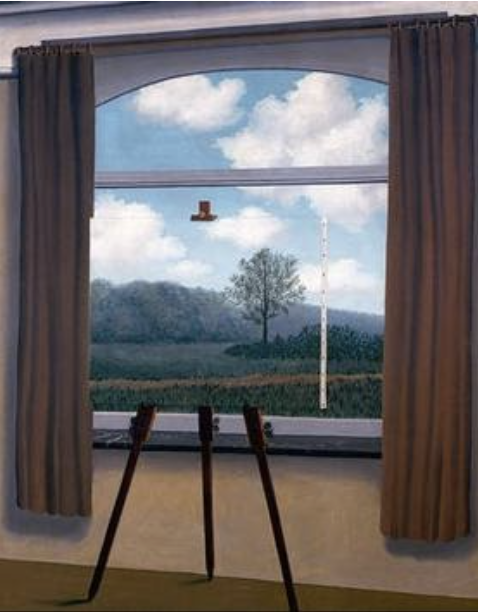The Speculative Condition
Posted on November 23, 2021“… no paradigm is ‘true,’… every one, including the one that sweetly shapes your own worldview, is a tremendously limited understanding of an immense and amazing universe that is far beyond human comprehension.”
– Donella Meadows, Thinking in Systems (164)
I thought a lot about Magritte’s The Human Condition (1933) painting in the first few weeks of quarantine. At the time, I was living alone in a one-bedroom apartment and working from home. I was viewing the world entirely through screens: during the workday, I was on video calls, sending emails, and making PowerPoints on my laptop, and during the evening I was FaceTiming my family, texting my friends, and reading the news on my phone. Screens were my gateway into the world, and I was addicted to my screens. I had a hard time feeling real.
I first saw Magritte’s painting when I was in sixth grade. My teacher had printed out photographs of famous paintings and scattered them across our desks. My class walked around the room and examined each of the printouts. She picked up the copy of Magritte’s painting and asked the class what we saw. Children shouted out about the window, the curtain, the trees, the sky, and the grass. She smiled as she asked ‘what else?,’ until a student noticed the easel situated in front of the window blending into the scene outside (begrudgingly, it wasn’t me). It is a painting of a painting of a window — the human condition. At home last year, my screens were the easel.

René Magritte, La condition humaine, 1933
In retrospect, I think eleven was a little young to be taught that each of our own realities are falsified, distorted representations and to question if we will ever really know ‘truth’ because truth may or may not exist and, if it did, maybe only through the the existence of falsehood, but it may not even matter at all (I’m paraphrasing). But, hey, I had already watched The Truman Show the year before, and I was going to read Plato’s Allegory of the Cave in English class the following year, so my premature existentialism was likely inevitable. An early acknowledgment of our distinct, individual realities did, however, 15 years later, make my segue into conversations about the criticality of plural realities in a time of a “rapi[d] move toward a monoculture” a little smoother (Dunne & Raby, 189).
In their book Speculative Everything, Dunne and Raby talk about speculative design as a medium to “broad[en] our conception of what is possible” (162). Existing in our own realities with our own ontologies, speculative design allows us to dream about the ‘what if’s’ of our world with potential to shift our views. The experience of seeing the Magritte painting as a way of recognizing the existence of my own reality, seeing the world as representation, and the individualist view of it all has often left me feeling disconnected. I took pause with that feeling when reading the following passage by Dunne and Raby: “One can’t help but wonder if ideology is at the source of true innovation in the sense that new ideas and thinking come from new and different ways of viewing the world” (167). Further, they argue: “If our belief systems and ideas don’t change, then reality won’t change either. It is our hope that speculating through design will allow us to develop alternative social imaginaries that open new perspectives on the challenges facing us” (189). Feeling bogged down by my own reality finds some resolve in the idea that design can be a tool to facilitate imagination and realities can shift. Meadows swiftly summarizes the importance of paradigm shifts in her discussion on effective ways to intervene in a system: “… people who have managed to intervene in systems at the level of paradigm have hit a leverage point that totally transforms systems” (163). It becomes then a way to see the easel from a different angle, or potentially re-painting the scene.
From feeling overwhelmed seeing the oil-painted easel on Magritte’s oil painting to the days of feeling like a mere online avatar, I find solace in the possibility of speculation. In the world of seven billion realities, I find inspiration in Dunne and Raby’s “challenge [to] give them form” (162).
-cb
References:
Dunne, Anthony, & Raby, Fiona. Speculative Everything: Design, Fiction, and Social Dreaming. MIT Press. 2014.
Magritte, René. La condition humaine. Oil on canvas. 1933.
Meadows, Donella H. Thinking in Systems: A Primer. Chelsea Green Publishing, 2015.